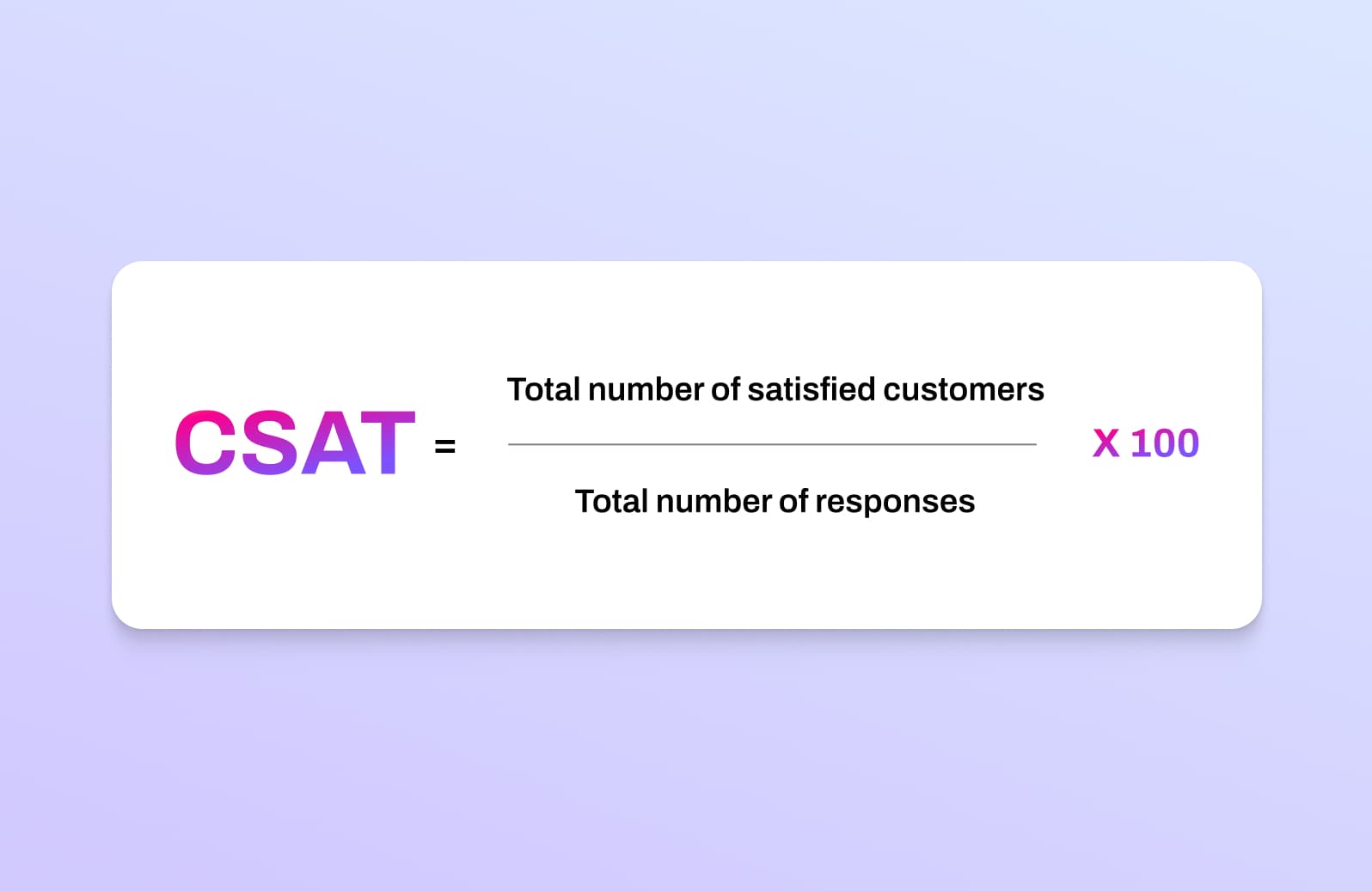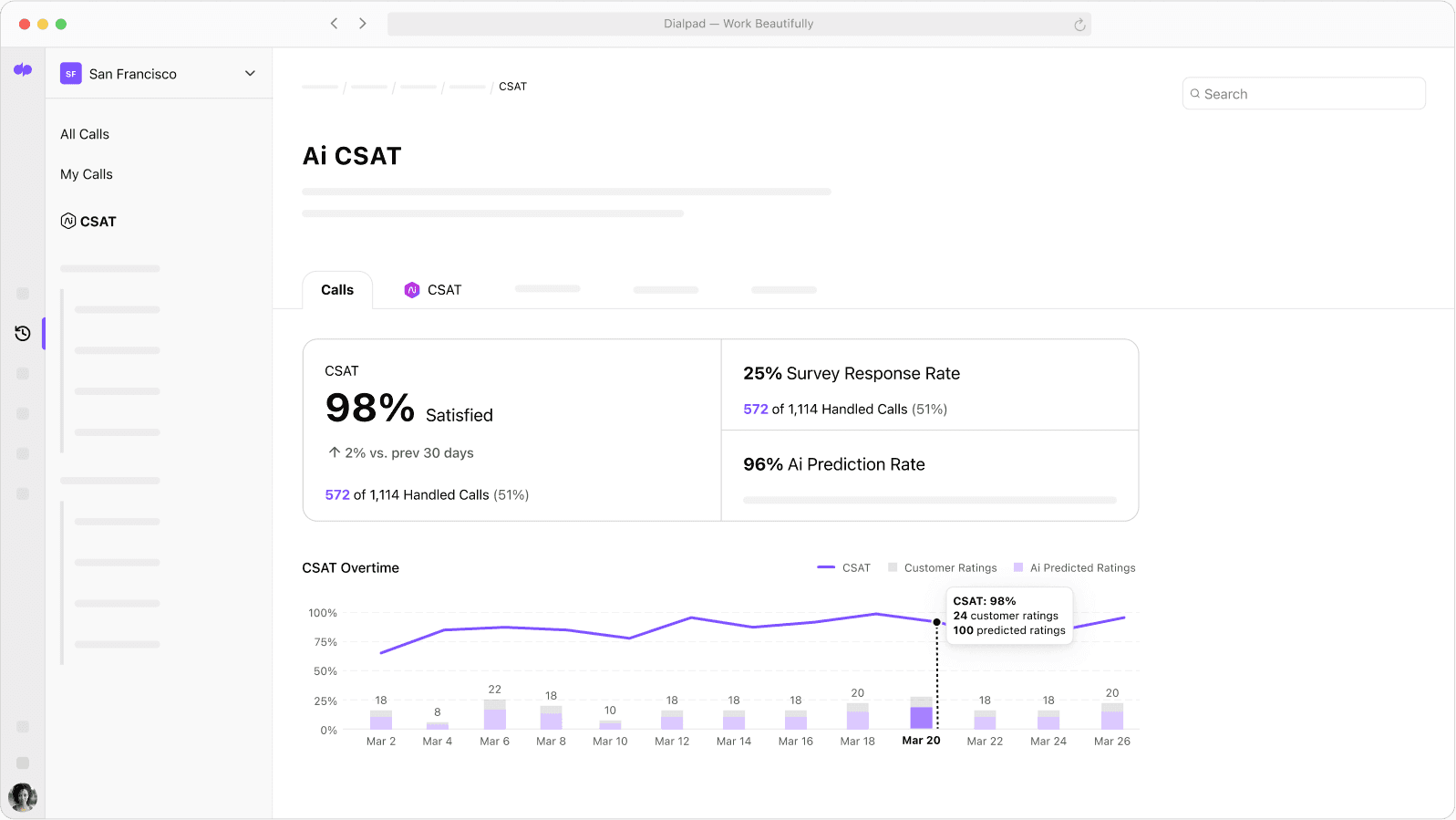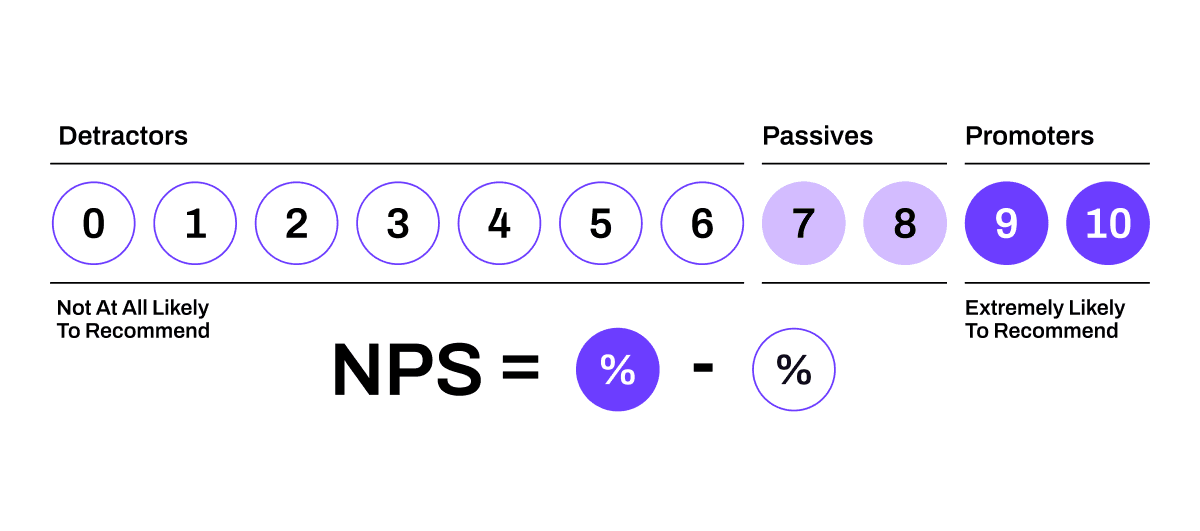How is it calculated?
What is a customer satisfaction score (CSAT)?
Customer satisfaction (CSAT) scores are useful for measuring how well your business is serving its customers. Whether you’re a small business in Sydney or a global enterprise in Wellington, healthy CSAT scores show you’re on the right track to retaining customers. Dialpad Ai Contact Centre makes it easy to gather customer satisfaction scores—even from customers who are too busy to answer CSAT questions (more on that below). Book a product tour to learn more!

What is a customer satisfaction score (CSAT)?
A CSAT score is how to measure customer satisfaction in a quantitative way. It gives you hard data showing how satisfied your customers are with your product, service, or company as a whole.
Using this customer satisfaction metric, you can measure how happy customers are with you after a purchase or other specific interaction with your business (like a support phone call).
Done right, it can help you get a better understanding of your customer journey and where you can make improvements, perhaps via workforce optimisation or by tweaking your product or service.
CSAT scores are often generated using data from customer satisfaction survey. A typical example of this is when a customer who interacts with your company is sent a brief survey asking them to rate their satisfaction level.
For a customer satisfaction survey like this, the customer might receive a survey question like, “How satisfied are you with your experience today?”, and be asked to rate their satisfaction on a rating scale of 1 to 5 or 1 to 10, with 5 or 10 being “very satisfied” and 1 being “not satisfied at all”.
For example, in Dialpad's cloud contact centre platform, there's a CSAT feature built in—you can create a survey in just a few seconds and have it play automatically after customer calls:

How do you calculate a customer satisfaction score?

Using customer satisfaction surveys, your business can collect a range of ratings from customers and then convert all of these results into an overall score, using the CSAT calculation given above.
CSAT scores range from 0 to 100. A CSAT score based on a CSAT survey would usually be calculated by dividing the total number of customers who gave a positive rating, such as a 4 or 5 on a scale of 1 to 5, by the total number of responses to the survey, and then multiplying this by 100.
For example, if 2,000 people completed your CSAT survey and 1,800 of them gave a positive rating of 4 or 5, the CSAT score would be 90% (1,800 positive responses / 2,000 total responses x 100 = 90).
✨ UPLEVEL YOUR CONTACT CENTRE
Grab the Contact Centre Playbook, which breaks down everything you need to know, from setup to improving customer satisfaction—with examples from real contact centre teams across different industries.
What makes a good customer satisfaction score?
What is a good CSAT score? That’s in many ways a more important question than “what is CSAT?”.
Your target CSAT score will depend on your industry. That said, a good CSAT score is typically between 75 and 85%. Statista recently published some data on customer satisfaction in Australia which should help you to assess CSAT score benchmarks for various industries.
To help you further, here’s a whistle-stop guide to what may be considered a good CSAT score in different niches:
Restaurant with full service: 80
Full-service restaurants have one of the highest CSAT score benchmarks out there. Restaurant customers have high expectations and anything less than full satisfaction after a meal can considerably impact a restaurant’s reputation.
Restaurant with limited service: 78
Limited-service restaurants have fewer interactions between employees and customers, so the benchmark isn’t quite as high in comparison to full-service restaurants. That said, customers still expect to have high-quality, efficiently served food—even in a fast-food restaurant.
Cleaning and personal care goods: 79
Whether we’re cleaning our homes or our faces, we want top quality products. We also expect efficient customer service when products aren’t up to standard, so cleaning and personal goods businesses have a high CSAT benchmark.
Clothing and apparel: 79
Clothing and apparel businesses often pride themselves on customer service, so it’s no surprise that they also have a high CSAT benchmark. Customers also may need to make returns or ask questions regarding products and these processes must be streamlined with CSAT in mind.
Ecommerce: 78
Ecommerce typically has more limited avenues for customer interactions, so CSAT scores may rely more on things like how satisfied customers are with the website or returns process. Since everything is online, it’s often easy to gather CSAT survey responses as these can be embedded into web pages and emails.
Specialty retail businesses: 77
Depending on where they're located and how competitive that area is, speciality retail businesses are usually either competing for their lives, or have it pretty easy.
Even so, customer satisfaction is important, and to stand out from competitors (if you're unlucky, these are table stakes), speciality retail businesses need excellent customer service and support at every stage of the customer journey.
Computer software: 76
Computer software companies can expect larger volumes of customer support queries in comparison to other industries, so their benchmark is a bit lower in comparison. If you've ever worked at a computer software company, then you've probably seen firsthand how hard they have to work to keep customers happy and loyal!
One of the biggest challenges of CSAT: Responsiveness of potential respondents
Calculating accurate CSAT scores relies on customer feedback. And first things first: They have to give you that feedback!
One of the biggest challenges that many of our customers (no matter what industries they're in) have seen is low response rates—not everyone will bother answering your survey, no matter how short it is, after a purchase or interaction.
In order for CSAT scores to be useful to you, you need enough of them, and they need to be accurate. What that means: The more CSAT scores you can collect, the better.
Another issue is that many unhappy customers might be more likely to respond to your survey than satisfied customers, which deceptively lowers your overall score. Encouraging all your customers to respond to surveys after an interaction will not only increase your CSAT response rates, but also make them more representative of how your customers feel overall. (Not just the angry ones!)
Dialpad's industry-first Ai CSAT feature is designed to solve exactly that. Not only can our Ai transcribe calls and analyse sentiment in real time, it can also infer CSAT scores for 100% of your customer calls thanks to its hyper-accurate transcription feature.
The result of introducing Ai CSAT? A much more representative sample size for CSAT scores, and a more accurate understanding of how satisfied your customers really are:

Difficulty determining training needs
Low CSAT survey response rates can create problems in your contact centre, too. CSAT metrics are a great way for contact centre managers to identify agents that need additional training or support—and without adequate customer service analytics, managers may be in the dark about who needs more coaching.
Monitoring business challenges
Monitoring CSAT scores allows your business, managers, and team leaders to monitor customer satisfaction over time. That means if a new product is released or you update your service in any way, you can measure CSAT scores in response.
If you don’t have many survey respondents, your CSAT scores might change dramatically over the course of the day, which won't give you a clear overall picture of customer satisfaction.

Try a contact centre platform with built-in CSAT
Book a demo of Dialpad Ai Contact Centre to see how it can help you measure customer satisfaction (and improve your CSAT metrics). Or, take a self-guided interactive tour of the app on your own!
When should you survey for customer satisfaction?
There are some key moments when you should survey your customers for CSAT scores. These will help you track satisfaction across the customer journey—while helping you be proactive about increasing customer retention and lowering customer churn.
After customer lifecycle moments
Customer lifecycle moments are the steps your customer takes throughout their interaction with your business. These can often be split into five stages:
Discovery: When a customer first discovers your brand.
Evaluation: When the customer learns about your brand and decides whether or not to purchase.
Purchase: The moment a customer purchases your product or service.
Experience: When the customer experiences and engages with the purchased product.
Retention: When a customer decides to purchase again or remain with your service or if they decide to leave.
Each of these lifecycle moments is a key time to assess how your customers feel. They will help you spot vulnerabilities in the customer journey where you may be losing sales and help you spot your strengths, too.
Here are some examples of how you might initiate a customer satisfaction survey at the above moments within your business’s customer lifecycle:
Discovery: Ask customers to rate their experience on your website or with your sales team.
Evaluation: Follow-up with customers after they have spoken with your sales team if they haven’t yet made a purchase and include a customer survey.
Purchase: Send customers a survey immediately after they have purchased a product or after customer onboarding for your service.
Experience: Follow-up with customers after they have had a chance to engage with their purchase.
Retention: Ask customers to complete a customer satisfaction survey six months before renewal date, after they renew, or after they cancel.
6 months before renewal
The last stage of the customer lifecycle is retention. Asking a customer to complete a survey after they've already cancelled is too late—although it is still helpful. One of the best times to survey for satisfaction is six months before renewal.
By surveying ahead of renewal, you can spot customers who are unlikely to renew their service. This is the moment for your sales team to step in ahead of time to secure that customer, perhaps with a new renewal deal.
After customer support / education touchpoints
Customer support or education touchpoints often fall outside of the standard customer lifecycle, but they're nonetheless vital moments to measure satisfaction, as they could make or break your customer loyalty.
This is why it’s so common to send customer satisfaction surveys after a customer has spoken with your support team. You may have also seen mini-surveys at the end of knowledge base web pages asking you to rate how helpful the page was. All of these indicate to the business how effective their support and education channels are.
In Dialpad, not only can you easily set up CSAT surveys in your online dashboard, you can also give your customers the option of elaborating on why they gave you a certain score!
Why do you need to measure your customer satisfaction score?
It helps you track how your team is performing on your customer-oriented goals
Effectively tracking how your employees are communicating with customers and fulfilling their needs is essential to any customer-oriented business. With CSAT scores, you can proactively measure customer satisfaction at various interaction points to track how well your teams are performing and spot anyone who needs additional training.
It makes it easier to identify what needs to be improved in your existing customer service strategies
By measuring CSAT at different points in the customer lifecycle, you can pinpoint exactly where you need to improve. This can save time and money as you know exactly where your service can be improved, allowing you to make smarter investments throughout your business.
👉 Case study time:
CSAT scores aren’t the only tool you can use for improving customer interactions. See how solarZero, a solar energy company, is using Dialpad's integrations to view call data and records all in one convenient place so that every aspect of their customer interactions, from call transcriptions to sales records, can be analysed quickly and effectively.
It uncovers insights on where the product or service falls short of your customers’ expectations
If you offer a multi-faceted product or service, it’s likely that customers could be satisfied with one element of the product,but not others. By following CSAT best practices and creating customer surveys that ask people to rate different aspects of your product or service, you can gain valuable insight into your own products from your customers.
Great satisfaction scores will help you stand out from competition
CSAT scores can also be a part of your marketing strategy. By advertising your CSAT scores, you can stand out from your competitors as a company that prides itself on customer satisfaction. Let potential customers know that 95% of your current customers are happy customers, and you’ll be reassuring them of the quality of your service.
It improves customer experience and loyalty
When it comes to improving customer experience and increasing customer loyalty, knowledge is power. More specifically, knowledge about your customers. The more you know about your customers’ levels of satisfaction, and where they're not happy, the better an experience you can provide for them.
Keeping track of your CSAT metrics is essential to helping you pinpoint where you’re succeeding and failing. Only then can you improve!
Speaking of which...
How can you improve your customer satisfaction scores?
Provide training for your team
The employee experience plays a large part in the customer experience, so regular training in customer service is a must for any member of your team that deals with customers. This should start with onboarding and be ongoing throughout their time at your company and, when needed, provided when any individual team member’s CSAT scores are down.
Clearly communicate your goals
It's going to be hard to improve your CSAT scores if your team doesn't know what your goals are. Which CSAT metrics are you measuring? How will you be measuring them? Everyone on your team, from new hires to seasoned agents, should be able to answer those questions.
Improve your hold time strategy
Putting customers on hold is inevitable for any call centre. But no one likes it and it can damage your CSAT scores. So, how can you improve your hold time strategy and keep customers happy?
Break up hold times
Agents need time to look up answers or speak to managers about customer queries. There isn’t much you can do to shorten this time beyond giving your agents all the information they need.
What your agents can do themselves, however, is break up hold times by checking in with their caller regularly to reassure them that they are working on their query.
Be honest with hold times
While it might be tempting to give customers overly optimistic estimated hold times, it can actually make them more frustrated as they wait for longer than expected.
Always be honest about hold times and make the most of hold tools that tell customers where they are in a queue.
We actually did some research into how hold times affect customer satisfaction—and the results were very interesting!
Automate your processes (where it makes sense to)
Automation is improving many aspects of customer service and helping businesses improve CSAT scores. In contact centres, for example, automation can route calls to the best agent for that customer’s query and trigger customer surveys following a call via SMS, email, or even social media!
You can also speed up resolution time by using a variety of automated tools together, like chatbots, social media, and SMS automated messaging, so that customers can get instant responses to their queries on the channels they prefer.
Track other supporting metrics like CES and NPS)
CSAT scores measure customer satisfaction, but there are other metrics you might want to track that go hand-in-hand with CSAT scores.
Two of these are customer effort scores (CES) and net promoter score (NPS), both of which help you measure overall customer satisfaction and customer lifetime value.
CES measures how much effort a customer has had to exert to complete an activity. This activity is usually how much effort was required for a support request to be fulfilled, but it could also include making a purchase, returning a product, or getting any issue resolved.
NPS measures customer loyalty. The most loyal customers are promoters, those who are loyal to your brand and would act as a referral and recommend you to friends. The least loyal customers are detractors, those who are not satisfied with your company and actively dissuade friends and family from your brand.

👉 Further reading:
Learn more about CSAT vs. NPS.
Review your team's performance regularly
Ultimately, great CSAT scores rely on not just meeting the needs and expectations of your customers, but doing it consistently.
You can also use CSAT scores to do this, but the important thing is to make a habit of it. After all, which is easier—catching little slips here and there because you're pulling the numbers every day or every week, or trying to figure out the cause of a huge dip in your CSAT metrics that's been happening over the last six months?
Are you measuring customer satisfaction scores?
CSAT surveys and scores are an opportunity to help your customers feel heard, gain insight into your customer-oriented services, and improve your customer loyalty and retention.
See how Dialpad can help you improve your CSAT scores
From easy CSAT survey creation to AI-powered features that can help you get a more comprehensive view of how your customers are feeling, there's a ton you can do in Dialpad Ai Contact Centre. Book a personal walkthrough to see how it works!
